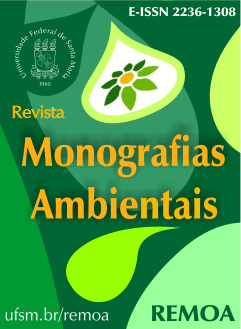Composting as an Alternative Allocation for Sludge Float Slaughterhouse of Chicken
DOI:
https://doi.org/10.5902/2236130815161Keywords:
Waste, Organic matter, Chicken abattoir, Environmentally correct disposalAbstract
Any human activity leads to the production of waste , however society requires continuous maintenance and improvement of environmental conditions , where various techniques of recycling or waste processing can be used . One technique that has been widely employed is composting , where biological degradation , aerobic or anaerobic organic waste in order to produce a humic substance to condition the soil occurs . The chicken slaughterhouses constitute major sources of pollution generators mainly of water . Thus this paper describes the application of composting as a means of disposal of sludge generated in wastewater treatment of a poultry slaughterhouse . Three different treatments were applied and evaluated some parameters such as temperature , odor , flies , ants , larvae in the windrow , and larvae in manure and manure moisture, pH , nitrogen, phosphorus , carbon and potassium. The results were satisfactory , with its particularities for each parameter in the positive and negative aspects.Downloads
References
BRASIL, Portaria nº 15/96, Ministério do Meio Ambiente, Diário Da República I série-B, nº19, p. 128-129, 1996.
BRASIL, Lei n. 12.305, de 2 de agosto de 2010, Política Nacional dos Resíduos Sólidos. Brasília, DF, 2 ago. 2010.
BUDZIAC, C. R., MAIA, C. M. B. F., MANGRICH, A. S., Transformações químicas da matéria orgânica durante a compostagem de resíduos da indústria madeireira, Quim. Nova, Vol. 27, Curitiba-PR, 2004. Disponível em: http://www.scielo.br/pdf/%0D/qn/v27n3/20165.pdf. Acesso em: 21 ago. 2013.
CARMO, M. I. de S. Manual da Prática da Compostagem Doméstica. In Câmara Municipal de Passos Ferreira. Ambisousa. 2008. Disponível em: http://www.uff.br/feuffrevistaquerubim/images/arquivos/publicacoes/zzquerubim_17_vol_2.pdf. Acesso em: 22 ago. 2013.
DIAS, S. M. F., VAZ, L. M. S., Métodos de Monitoramento no processo aeróbico de compostagem-EEA/UEFS, Feira de Santana, n. 15, Bahia, 1996. Disponível em: http://www2.uefs.br/sitientibus/pdf/15/metodos_de_monitoramento.pdf. Acesso em: 21 ago. 2013.
EMATER DF. Caderno de Inovações Tecnológicas, 2010. Disponível em:http://www.emater.df.gov.br/sites/200/229/00002106.pdf. Acesso em: 30 mai. 2012.
EMBRAPA, Comparação de Composto Orgânico de Barcarena com Adubos Orgânicos Tradicionais Quanto às Propriedades Químicas, Belém-PA, 2002. Disponível em: http://ainfo.cnptia.embrapa.br/digital/bitstream/item/27836/1/com.tec.70.pdf. Acesso em: 27 jun. 2013.
FERNANDES, F., et al, Manual prático para a compostagem de Biossólidos, PROSAB, 1996. Disponível em: http://www.finep.gov.br/prosab/livros/Livro%20Compostagem.pdf. Acesso em: 29 out. 2013.
KIEHL, E.J. Manual de compostagem: maturação e qualidade do composto. 4ª ed. E. J. Kiehl. Piracicaba. 173 p., 2004.
MORAES, L. de M., JUNIOR, D. R. de P., Gerenciamento de Resíduos de Abatedouro de Aves: Alternativas de Manejo de Tratamento, São Paulo, 2006. Disponível em: http://www.bvsde.paho.org/bvsaidis/brasil20/iii-019.pdf. Acesso em: 29 out. 2013.
PEREIRA, NETO J.T. 2007. Manual de compostagem: processo de baixo custo. UFV. Viçosa. 81 p.
PRIMAVESI, A. O manejo ecológico do solo: agricultura em regiões tropicais. Nobel. São Paulo. 535 p., 1981
SILVA, A. C, et al. Mineralização de nitrogênio e enxofre em solos brasileiros Sob influência da calagem e fósforo. 1998. Disponível em: <http://www.scielo.br/pdf/pab/v34n9/7620.pdf. Acesso em: 29 out. 2013.
Downloads
Published
How to Cite
Issue
Section
License
Ethical guidelines for journal publication
The REMOA is committed to ensuring ethics in publication and quality of articles.
Conformance to standards of ethical behavior is therefore expected of all parties involved: Authors, Editors, Reviewers, and the Publisher.
In particular,
Authors: Authors should present an objective discussion of the significance of research work as well as sufficient detail and references to permit others to replicate the experiments. Fraudulent or knowingly inaccurate statements constitute unethical behavior and are unacceptable. Review articles should also be objective, comprehensive, and accurate accounts of the state of the art. The authors should ensure that their work is entirely original works, and if the work and/or words of others have been used, this has been appropriately acknowledged. Plagiarism in all its forms constitutes unethical publishing behavior and is unacceptable. Submitting the same manuscript to more than one journal concurrently constitutes unethical publishing behavior and is unacceptable. Authors should not submit articles describing essentially the same research to more than one journal. The corresponding author should ensure that there is a full consensus of all co-authors in approving the final version of the paper and its submission for publication.
Editors: Editors should evaluate manuscripts exclusively on the basis of their academic merit. An editor must not use unpublished information in the editor's own research without the express written consent of the author. Editors should take reasonable responsive measures when ethical complaints have been presented concerning a submitted manuscript or published paper.
Reviewers: Any manuscripts received for review must be treated as confidential documents. Privileged information or ideas obtained through peer review must be kept confidential and not used for personal advantage. Reviews should be conducted objectively, and observations should be formulated clearly with supporting arguments, so that authors can use them for improving the paper. Any selected referee who feels unqualified to review the research reported in a manuscript or knows that its prompt review will be impossible should notify the editor and excuse himself from the review process. Reviewers should not consider manuscripts in which they have conflicts of interest resulting from competitive, collaborative, or other relationships or connections with any of the authors, companies, or institutions connected to the papers.






